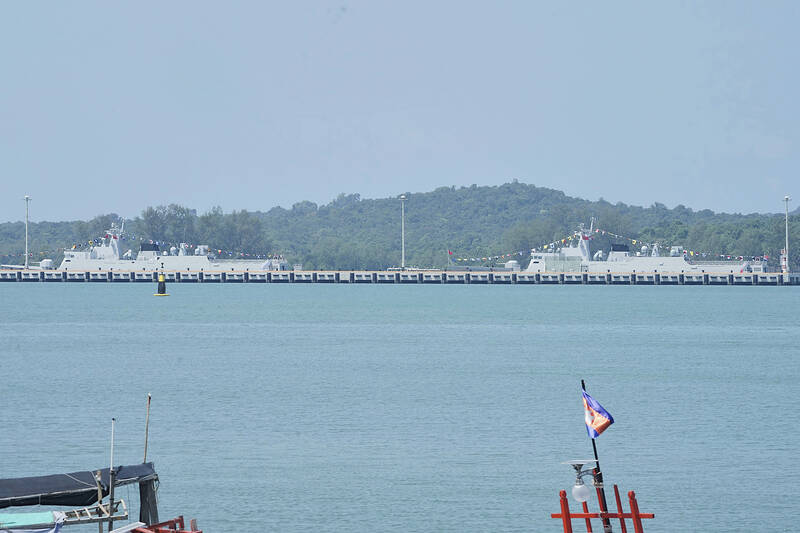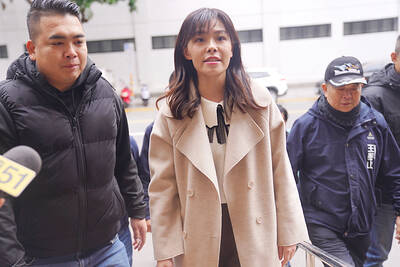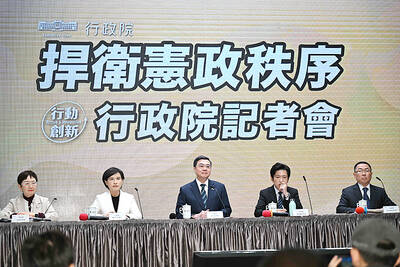Cambodia and China yesterday began their largest-ever joint military exercises, involving advanced Chinese military hardware including artillery, warships and robot battle dogs.
Cambodia has long been an ally of China, receiving billions of dollars in investments, while Washington has voiced concerns that Beijing is using a Cambodian naval base it renovated on the Gulf of Thailand to expand its influence in the region.
Nearly 900 Chinese military personnel and more than 1,300 Cambodian soldiers are taking part in the drills that are to last until May 28, the Royal Cambodian Armed Forces (RCAF) said in a statement.

Photo: AP
The drills would feature advanced Chinese military hardware, including armored vehicles, helicopters, warships, reconnaissance drones and robot battle dogs, the statement said.
The annual exercises were to “develop deeper ties and cooperation” between the two armies, it said.
“The exercises are bigger than last year in terms of both personnel and equipment,” RCAF spokesman Thong Solimo told reporters.
A large Chinese naval vessel, the Changbai Shan, on Monday docked at Cambodia’s Beijing-renovated Ream Naval Base with the military equipment for the drills, he said.
Cambodian political analyst Ou Virak told reporters that “China does want to flex its muscle” and to send a message that “it’s a superpower” through the exercises, dubbed Golden Dragon.
“Definitely China is trying to ... grow its influence within the region,” he said.
“Beyond just flexing the muscle, it needs to build confidence amongst its partners to say to the partners that China is growing, China is expanding, China is also getting stronger, both in size, but also in technological advancement, as well as military might,” Ou Virak added.
Cambodia is also expected to receive two warships from China.
The first Golden Dragon drills were held in 2016, and in early 2017 Cambodia scrapped a similar joint exercise — Angkor Sentinel — which had been held for the preceding seven years with US forces.
The drills follow a two-day visit by Chinese President Xi Jinping (習近平) to Cambodia last month to deepen ties between the two countries.

The US government has signed defense cooperation agreements with Japan and the Philippines to boost the deterrence capabilities of countries in the first island chain, a report by the National Security Bureau (NSB) showed. The main countries on the first island chain include the two nations and Taiwan. The bureau is to present the report at a meeting of the legislature’s Foreign Affairs and National Defense Committee tomorrow. The US military has deployed Typhon missile systems to Japan’s Yamaguchi Prefecture and Zambales province in the Philippines during their joint military exercises. It has also installed NMESIS anti-ship systems in Japan’s Okinawa

‘WIN-WIN’: The Philippines, and central and eastern European countries are important potential drone cooperation partners, Minister of Foreign Affairs Lin Chia-lung said Minister of Foreign Affairs Lin Chia-lung (林佳龍) in an interview published yesterday confirmed that there are joint ventures between Taiwan and Poland in the drone industry. Lin made the remark in an exclusive interview with the Chinese-language Liberty Times (the Taipei Times’ sister paper). The government-backed Taiwan Excellence Drone International Business Opportunities Alliance and the Polish Chamber of Unmanned Systems on Wednesday last week signed a memorandum of understanding in Poland to develop a “non-China” supply chain for drones and work together on key technologies. Asked if Taiwan prioritized Poland among central and eastern European countries in drone collaboration, Lin

BACK TO WORK? Prosecutors said they are considering filing an appeal, while the Hsinchu City Government said it has applied for Ann Kao’s reinstatement as mayor The High Court yesterday found suspended Hsinchu mayor Ann Kao (高虹安) not guilty of embezzling assistant fees, reducing her sentence to six months in prison commutable to a fine from seven years and four months. The verdict acquitted Kao of the corruption charge, but found her guilty of causing a public official to commit document forgery. The High Prosecutors’ Office said it is reviewing the ruling and considering whether to file an appeal. The Taipei District Court in July last year sentenced Kao to seven years and four months in prison, along with a four-year deprivation of civil rights, for contravening the Anti-Corruption

NO CONFIDENCE MOTION? The premier said that being toppled by the legislature for defending the Constitution would be a democratic badge of honor for him Premier Cho Jung-tai (卓榮泰) yesterday announced that the Cabinet would not countersign the amendments to the local revenue-sharing law passed by the Legislative Yuan last month. Cho said the decision not to countersign the amendments to the Act Governing the Allocation of Government Revenues and Expenditures (財政收支劃分法) was made in accordance with the Constitution. “The decision aims to safeguard our Constitution,” he said. The Constitution stipulates the president shall, in accordance with law, promulgate laws and issue mandates with the countersignature of the head of the Executive Yuan, or with the countersignatures of both the head of the Executive Yuan and ministers or